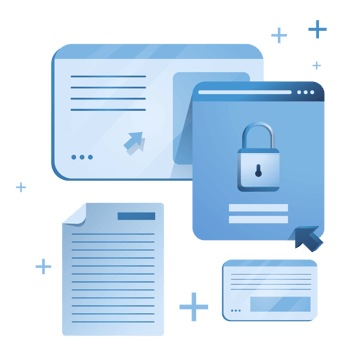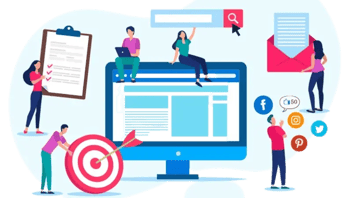Inbound Lead Generation: Transformarea vizitatorilor în clienți
Unul dintre principalele obiective ale marketingului inbound este generarea de clienți potențiali - clienți potențiali care și-au manifestat interesul pentru produsul sau serviciul dumneavoastră. Dar generarea de lead-uri inbound în sine nu este suficientă. Pentru a beneficia cu adevărat de inbound marketing, trebuie să transformați aceste piste în clienți plătitori.

Inbound marketing este o strategie care se concentrează pe atragerea, implicarea și încântarea clienților prin conținut relevant și valoros. Este o modalitate de a câștiga atenția și încrederea potențialilor clienți, mai degrabă decât de a utiliza formele tradiționale de publicitate pentru a-i întrerupe. Și este una dintre abordările de generare de lead-uri cu cel mai mare randament al investiției (ROI).
De ce este importantă generarea de lead-uri Inbound?
-
80% dintre marketeri spun că lead nurturing-ul este esențial pentru conversia lead-urilor în clienți. Lead nurturing este o componentă esențială a oricărei strategii de inbound marketing.
-
Companiile care îngrijesc lead-urile înregistrează o creștere cu 25% a ratelor de închidere. Nutrirea lead-urilor este esențială pentru a crește probabilitatea de a le transforma în clienți plătitori.
-
Campania medie de hrănire a lead-urilor durează 12 săptămâni. În timp ce hrănirea lead-urilor poate dura luni, rezultatele merită investiția pentru companiile care doresc să își crească șansele de a transforma lead-urile în clienți plătitori.
-
Cele mai eficiente tactici de hrănire a prospecților includ e-mailul, social media și marketingul de conținut. Aceste tactici vor asigura faptul că potențialii clienți rămân informați și implicați în ofertele și serviciile companiei dumneavoastră.
-
Cel mai bun mod de a măsura succesul campaniei dvs. de stimulare a potențialilor clienți este de a urmări numărul de clienți potențiali care se transformă în clienți. Analiza numărului de clienți potențiali care se transformă în clienți vă va permite să evaluați eficacitatea tacticilor dvs. și să faceți ajustările necesare campaniei dvs.
Prin valorificarea acestor tendințe, întreprinderile pot dezvolta strategii eficiente de lead-nurturing și pot transforma mai multe lead-uri în clienți.
Deci, cum puteți face acest lucru? Iată câteva sfaturi pentru conversia lead-urilor din inbound marketing în clienți:
Hrăniți clienții potențiali cu conținut direcționat.
Hrănirea clienților potențiali cu conținut direcționat este esențială pentru succesul strategiilor de inbound marketing.
-
Definiți traseul cumpărătorului. Primul pas către hrănirea clienților potențiali cu conținut direcționat este identificarea parcursului cumpărătorului pentru publicul țintă. Acest lucru înseamnă să înțelegeți cine sunt aceștia, care sunt interesele lor, punctele lor dureroase și cum iau decizii. Puteți face acest lucru efectuând studii de piață, chestionându-vă clienții actuali și analizând traficul de pe site-ul dvs.
-
Creați conținut valoros. Odată ce vă înțelegeți publicul țintă, puteți crea conținut valoros care să se adreseze direct nevoilor și intereselor lor. Acest conținut poate include postări pe blog, infografice, cărți electronice, studii de caz și webinare. Cheia este să creați conținut relevant, informativ și captivant.
-
Distribuiți-vă conținutul. Odată ce ați creat conținut valoros, trebuie să îl distribuiți publicului țintă. Campaniile de marketing prin e-mail sunt o modalitate eficientă de a hrăni clienții potențiali cu conținut direcționat. Prin segmentarea listei dvs. de e-mailuri în funcție de interesele și comportamentele clienților dvs. potențiali, puteți trimite campanii direcționate care sunt extrem de relevante pentru nevoile și interesele acestora în starea specifică a parcursului cumpărătorului. De asemenea, puteți utiliza instrumente de automatizare pentru a declanșa e-mailuri pe baza unor acțiuni specifice întreprinse de abonații dumneavoastră, cum ar fi descărcarea unui whitepaper sau vizitarea unei anumite pagini de pe site-ul dumneavoastră.
O altă modalitate de hrănire a clienților potențiali cu conținut direcționat este prin intermediul campaniilor de social media. Vă puteți angaja cu publicul țintă și puteți construi relații cu potențialii clienți prin postarea de conținut relevant și valoros pe platformele social media. De asemenea, puteți utiliza publicitatea în social media pentru a viza date demografice și interese specifice, ceea ce vă permite să ajungeți la un public foarte bine direcționat cu conținutul dvs. -
Urmăriți-vă rezultatele. Este esențial să urmăriți rezultatele campaniilor dvs. de lead nurturing pentru a vedea ce funcționează și ce nu. Puteți urmări măsurători precum ratele de deschidere, de clic și de conversie. Aceste informații vă vor ajuta să vă îmbunătățiți campaniile în timp.
Pe lângă marketingul prin e-mail și social media, alte canale de hrănire a clienților potențiali cu conținut direcționat includ site-ul dvs. web, blogul, alte platforme online și canale offline, cum ar fi expozițiile comerciale, evenimentele și materialele tipărite.
Exemplu: Dacă ați vinde software pentru întreprinderile mici, ați putea:
-
-
-
Creați o postare pe blog despre principalele provocări cu care se confruntă întreprinderile mici. Această postare ar fi relevantă pentru publicul dvs. țintă și v-ar ajuta să construiți relații cu potențialii clienți.
-
Creați infografice despre beneficiile utilizării software-ului dvs.; acestea sunt atractive din punct de vedere vizual și vă ajută să împărtășiți mesajul dvs. cu un public mai larg.
-
Organizați un webinar despre modul de utilizare a software-ului dumneavoastră. Acest webinar ar fi o modalitate excelentă de a educa potențialii clienți cu privire la produsul dvs. și de a răspunde întrebărilor acestora.
-
-
Utilizați lead magnets pentru a capta adrese de e-mail.
Lead Magnets sunt un instrument puternic de captare a adreselor de e-mail și de creștere a listei dvs. Un lead magnet este o resursă gratuită sau o ofertă extrem de valoroasă pentru publicul dvs. țintă, care se schimbă în schimbul adresei lor de e-mail. Oferind un lead magnet, puteți atrage potențialii abonați să vă dea adresele lor de e-mail, permițându-vă să îi hrăniți cu conținut direcționat și, în cele din urmă, să îi transformați în clienți plătitori.
Puteți utiliza mai multe tipuri de lead magnets pentru a capta adrese de e-mail, iar cel mai bun pentru afacerea dvs. va depinde de publicul țintă și de produsele sau serviciile pe care le oferiți. Câteva exemple de lead magnets includ:
-
Ebooks și whitepapers: Acestea sunt resurse aprofundate care oferă informații valoroase pe un anumit subiect. Acestea sunt adesea mai lungi decât postările pe blog și sunt mai cuprinzătoare.
-
Liste de verificare și modele: Aceste resurse practice vă ajută publicul țintă să îndeplinească o sarcină sau un obiectiv specific. Ele sunt adesea ușor de consumat și oferă o valoare imediată.
-
Cursuri și webinarii: Acestea sunt experiențe de învățare mai aprofundate care pot fi furnizate online. Acestea pot fi o modalitate excelentă de a vă prezenta expertiza și de a oferi valoare publicului țintă.
-
Teste gratuite și demonstrații: Acestea sunt o modalitate foarte bună de a permite publicului țintă să încerce produsul sau serviciul dumneavoastră înainte de a-l achiziționa.
Pentru a utiliza în mod eficient lead magnets pentru a capta adrese de e-mail, trebuie să le faceți foarte vizibile și ușor de accesat. Acest lucru înseamnă să le promovați în mod vizibil pe site-ul dvs. și pe canalele social media și să utilizați apeluri la acțiune pentru a încuraja vizitatorii să se înscrie. De asemenea, ar trebui să le facilitați vizitatorilor înscrierea în lista dvs. de e-mailuri prin furnizarea unui formular clar și simplu pe care să îl completeze.
Odată ce ați capturat adresele de e-mail ale potențialilor abonați, este esențial să le urmăriți și să continuați să le oferiți valoare prin campanii de e-mail specifice și alte forme de comunicare. Acest lucru vă va ajuta să construiți relații cu abonații dvs. și să îi transformați în clienți plătitori.
Exemplu de lead magnet pe care l-ați putea utiliza pentru a capta adresele de e-mail:
Ebook gratuit: Ghidul suprem pentru [tema dvs.]
Acest ebook te va învăța tot ce trebuie să știi despre [subiectul tău]. Veți descoperi cele mai recente tendințe, cele mai bune practici și studii de caz. Acest ebook este resursa perfectă pentru oricine dorește să afle mai multe despre [subiectul tău].
Pentru a descărca cartea dvs. electronică gratuită, introduceți pur și simplu adresa dvs. de e-mail mai jos:
[Formular de înscriere prin e-mail]
Utilizați automatizarea pentru a eficientiza hrănirea.
Lead nurturing este esențială pentru orice strategie de inbound marketing, deoarece vă ajută să construiți relații cu potențialii clienți și să îi ghidați prin pâlnia de vânzări. Prin furnizarea de conținut valoros, relevant și consecvent pentru publicul țintă, puteți atrage și păstra un grup clar definit de clienți și puteți determina acțiuni profitabile ale clienților.
O modalitate de a eficientiza procesul de hrănire a clienților este utilizarea automatizării. Cu ajutorul instrumentelor de automatizare, puteți declanșa e-mailuri direcționate, postări pe rețelele sociale și alte forme de comunicare în funcție de acțiunile clienților dvs. potențiali. Acest lucru vă permite să transmiteți mesaje personalizate și oportune clienților dvs. potențiali fără a le trimite manual pe fiecare în parte.
Iată câteva moduri în care puteți utiliza automatizarea pentru a eficientiza hrănirea lead-urilor:
-
Configurați campanii automate de e-mail: Prin segmentarea listei dvs. de e-mailuri în funcție de interesele și comportamentele clienților dvs. potențiali, puteți crea campanii de e-mailuri direcționate care sunt foarte relevante pentru nevoile și interesele acestora. De asemenea, puteți utiliza instrumente de automatizare pentru a declanșa e-mailuri pe baza unor acțiuni specifice întreprinse de lead-urile dvs., cum ar fi descărcarea unui whitepaper sau vizitarea unei anumite pagini de pe site-ul dvs.
-
Utilizați automatizarea social media: Puteți utiliza instrumente de automatizare pentru a programa postările pe rețelele sociale în avans și pentru a declanșa postările pe baza acțiunilor specifice întreprinse de clienții dvs. potențiali. Acest lucru vă permite să vă mențineți canalele de social media active și atractive fără a le monitoriza constant.
-
Implementați chatbots AI: Chatbots-urile sunt programe de chat automatizate care interacționează cu clienții dvs. potențiali în timp real. Acestea pot răspunde întrebărilor frecvente, pot oferi recomandări personalizate și pot programa întâlniri sau demonstrații.
-
Utilizați software de automatizare a marketingului: Software-ul de automatizare a marketingului este un instrument puternic care automatizează diverse sarcini de marketing, cum ar fi marketingul prin e-mail, marketingul pe rețelele sociale și gestionarea liderilor. Puteți să vă raționalizați eforturile de hrănire a clienților potențiali utilizând software-ul de automatizare a marketingului și să economisiți timp și resurse atunci când vă deplasați clienții potențiali prin pâlnia de conversie.
Pentru a utiliza în mod eficient automatizarea în vederea eficientizării activității de lead nurturing, este esențial să vă definiți obiectivele de lead nurturing și să creați un plan clar de utilizare a automatizării pentru atingerea acestora. De asemenea, ar trebui să vă segmentați cu atenție clienții potențiali și să creați campanii specifice care să se adreseze direct nevoilor și intereselor acestora. Nu uitați să vă monitorizați și să vă optimizați eforturile de automatizare pentru a vă asigura că acestea produc rezultatele dorite.
Exemplu: Utilizarea automatizării pentru hrănirea clienților potențiali atunci când vindeți software pentru întreprinderile mici. Ați putea:
-
-
-
Configurați o campanie automată de e-mail care să trimită e-mailuri clienților potențiali care descarcă ebook-ul dvs. despre principalele provocări ale întreprinderilor mici. E-mailurile ar putea include sfaturi și recomandări cu privire la modul de depășire a acestor provocări, precum și linkuri către alte resurse care ar putea fi utile.
-
Utilizați automatizarea social media pentru a programa o serie de postări pe paginile de social media ale companiei dvs. care să promoveze ebook-ul dvs. și să ofere sfaturi și recomandări cu privire la provocările cu care se confruntă întreprinderile mici.
-
Ați putea implementa un chatbot pe site-ul dvs. care să răspundă la întrebările frecvente despre software-ul dvs. și să ofere recomandări personalizate clienților potențiali.
-
-
Calificați clienții potențiali înainte de a investi timp și energie.
Calificarea lead-urilor este esențială în vânzări, deoarece ajută la determinarea lead-urilor care vor deveni clienți plătitori. Prin calificarea clienților potențiali, vă puteți prioritiza eforturile și vă puteți aloca timpul și resursele mai eficient, ceea ce va duce la un randament mai mare al investițiilor.
Atunci când calificați clienții potențiali, puteți lua în considerare mai mulți factori; criteriile specifice vor depinde de activitatea dumneavoastră și de publicul țintă. Printre factorii comuni de luat în considerare se numără:
-
Bugetul: Are clientul potențial bugetul necesar pentru a face o achiziție? Acest lucru este deosebit de important dacă oferiți produse sau servicii cu prețuri ridicate.
-
Autoritatea: Liderul are autoritatea necesară pentru a lua o decizie de cumpărare? Aceasta poate include factorii de decizie din cadrul unei companii, cum ar fi directorul general sau directorul financiar.
-
Nevoia: Liderul are nevoie de produsul sau serviciul dumneavoastră? Este posibil ca aceștia să fie pregătiți să cumpere doar dacă au o nevoie urgentă.
-
Momentul: Este clientul potențial pregătit să cumpere acum sau în viitorul apropiat? Dacă nu sunt pregătiți să facă o achiziție, s-ar putea să nu merite să investiți timp și resurse în încercarea de a încheia afacerea.
Pentru a califica eficient clienții potențiali, ar trebui să utilizați o combinație de cercetare online și offline și de comunicare directă cu aceștia. De exemplu, puteți utiliza social media și alte platforme online pentru a aduna informații despre activitatea și nevoile clientului potențial. De asemenea, puteți utiliza e-mailul, telefonul sau comunicarea în persoană pentru a pune întrebări și a colecta mai multe date.
Exemplu: Calificați clienții potențiali atunci când vindeți software pentru întreprinderile mici. Ați putea:
-
-
-
Întrebați liderul despre dimensiunea companiei, sectorul de activitate și buget. De asemenea, ați putea să îi întrebați despre provocările lor actuale și despre modul în care doresc să își îmbunătățească afacerea.
-
Utilizați social media pentru a cerceta compania potențialului client. De exemplu, ați putea consulta site-ul web, paginile de social media și profilurile angajaților companiei liderului. Acest lucru vă poate oferi o bună înțelegere a activității și nevoilor clientului potențial.
-
Programați o convorbire telefonică cu clientul potențial pentru a pune mai multe întrebări și a aduna mai multe informații. Aceasta este o ocazie excelentă de a stabili o relație cu clientul potențial și de a afla mai multe despre activitatea sa.
-
-
Prin concentrarea generării de leaduri inbound pe conversia clienților, vă asigurați că toată munca grea depusă pentru crearea unei strategii de conținut, dezvoltarea, optimizarea și obținerea unui clasament SEO ridicat este răsplătită cu generarea efectivă de venituri. Acest lucru este crucial în transformarea strategiei dvs. de marketing inbound în profit real și în stabilirea dvs. ca brand.
Acest conținut este disponibil și în:
- Germană: Inbound-Lead-Generierung: Besucher in Kunden verwandeln
- Engleză: Inbound Lead Generation: Turning Visitors into Customers
- Spaniolă: Generación de clientes potenciales: Convertir visitantes en clientes
- Franceză: Génération de leads inbound : Transformer les visiteurs en clients
- Italiană: Generazione di lead inbound: Trasformare i visitatori in clienti
- Chineză: 内向型潜在客户生成:将访客转化为客户






Lasă un comentariu cu părerea ta.